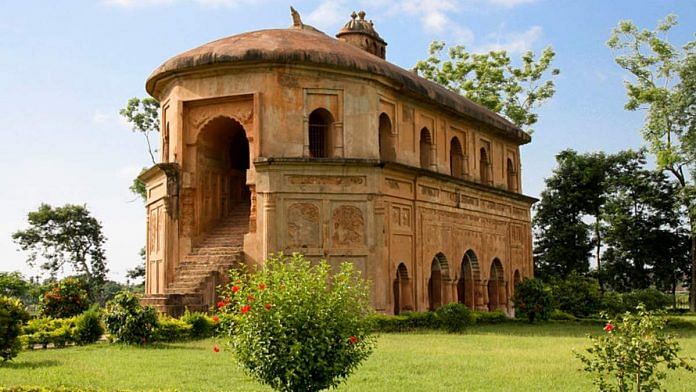New Delhi: Finance Minister Nirmala Sitharaman Saturday unveiled a plan in the Union Budget to develop five archaeological sites into “iconic” sites. The government also announced development of museums at these sites.
The five sites are Rakhigari (Haryana), Hastinapur (Uttar Pradesh), Sivasagar (Assam), Dholavira (Gujarat) and Adichanallur (Tamil Nadu) — all of which fall in either BJP-ruled states or where it is an alliance partner.
Sitharaman also allocated Rs 3,150 crore for the Ministry of Culture, under which the sites fall.
Track live updates on Union Budget 2020 here.
Rakhigarhi
Rakhigarhi is among the largest known townships of the Harappan civilisation, which existed between 2,600-1,800 BC. It is located in the Hisar district of Haryana, approximately 150 kilometres north-west of Delhi.
The site, which consists of seven mounds, was discovered by the Archeological Survey of India in 1963.
Excavations in Rakhigarhi have traced this civilisation to as early as 5,500 BC. The site gained prominence last year when a study of DNA samples of the skeletons found there showed that there are no traces of the R1a1 gene or Central Asian ‘steppe’ genes, loosely termed as the ‘Aryan gene’.
In 2012, the Global Heritage Fund declared Rakhigarhi as one of the 10 most endangered heritage sites in Asia because of the encroachments into the area.
Also read: 8% rise in budget for Jal Shakti, ministry handling Modi dream of piped water for all
Hastinapur
Hastinapur is located in Meerut and is considered to be the capital of the ‘Kuru Kingdom’.
The site is part of the ASI’s list of ‘Mahabharata sites,’ which are places that are believed to have been featured in the epic. Hastinapur is believed to have been the capital of the kingdom of the Pandavas and Kauravas. It has also found mention in ancient Jain texts.
Even though archaeologists claim to have found deposits of a layer associated with the Mahabharata time-period, they have failed to find it in a stratified form. Excavations at the Mahabharata sites — including Hastinapura — seek to find this link.
Sivasagar
Sivasagar is named after a lake in the city of Sivasagar in Assam, which was the epicentre of the Ahom kingdom that existed in the Brahmaputra Valley between the 13th and 19th century CE.
Assam history has a special reference to the Ahom regime.
The site hosts burial mounds of the kings who ruled the Ahom kingdom for 600 years, and they were made a part of the world heritage sites in 2014.
There are several prominent tourism sites — the Rang Ghar, Talatal Ghar, Namdang Stone Bridge — built by Ahom rulers.
Rang Ghar used to be a site for buffalo fights and other sports for the Ahom rulers. The Talatal Ghar was initially an army base camp for the Ahom kings, used during wars, while the Namdang Stone Bridge was a connecting bridge between Assam and the rest of India.
Dholavira
Like Rakhigari, Dholavira, which is located in the Kutch district of Gujarat, is also a site of Harappan civilisation.
It was discovered by the ASI in 1967. Artefacts found in Dholavira included terracotta pottery, beads, gold and copper ornaments, tools, urns and some imported vessels that indicate trade links with lands as far away as Mesopotamia.
Dholavira was a thriving metropolis during the 3,000 BCE-1,800 BCE period. According to the UNSECO, “Globally, Dholavira can be compared to the cities of Ancient River Valley Civilization, the urban metropolises of Egyptian, Chinese and Mesopotamian.”
Adichanallur
This is a site located in Thoothukudi district, Tamil Nadu, and is believed to be dating backing to 696-905 BC, making it the oldest site in the state so far.
Adichanallur is an urn-burial site, first discovered in 1876. In 2005, around 169 clay urns containing human skeletons, nearly 3,800 years old, were unearthed.
Apart from the skeletons, several gold diadems with a hole on each end for tying them around the forehead were also found, along with a number of bronze figurines of buffalos, goats tigers, and elephants.
Also read: Modi govt allocates Rs 4,400 cr for cleaner air — big jump from Rs 460 cr in last budget




as expected fro print’s political taste, why BJP comes in this article?? do not make non-political things political.
Dear, Nirmala sitaraman kindly include Karnatakas encient 2 citys namely Banavasi and koppala.inthe iconic site list.
Banavasi 3rd century BC globally known place.and koppala also 2rd century to 3nd century BC , where Emperor Ashokas inscription says,”Divinity is not a high society
People’s property. others can also achieve it by their virtue. “(from the research article by emeritus archaelogist Dr. s setter.)